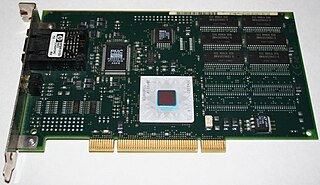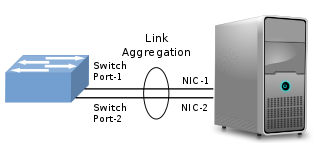Related Research Articles

Asynchronous Transfer Mode (ATM) is a telecommunications standard defined by the American National Standards Institute and ITU-T for digital transmission of multiple types of traffic. ATM was developed to meet the needs of the Broadband Integrated Services Digital Network as defined in the late 1980s, and designed to integrate telecommunication networks. It can handle both traditional high-throughput data traffic and real-time, low-latency content such as telephony (voice) and video. ATM provides functionality that uses features of circuit switching and packet switching networks by using asynchronous time-division multiplexing.
Multiprotocol Label Switching (MPLS) is a routing technique in telecommunications networks that directs data from one node to the next based on labels rather than network addresses. Whereas network addresses identify endpoints the labels identify established paths between endpoints. MPLS can encapsulate packets of various network protocols, hence the multiprotocol component of the name. MPLS supports a range of access technologies, including T1/E1, ATM, Frame Relay, and DSL.
Quality of service (QoS) is the description or measurement of the overall performance of a service, such as a telephony or computer network, or a cloud computing service, particularly the performance seen by the users of the network. To quantitatively measure quality of service, several related aspects of the network service are often considered, such as packet loss, bit rate, throughput, transmission delay, availability, jitter, etc.
Network throughput refers to the rate of message delivery over a communication channel, such as Ethernet or packet radio, in a communication network. The data that these messages contain may be delivered over physical or logical links, or through network nodes. Throughput is usually measured in bits per second, and sometimes in data packets per second or data packets per time slot.
A network switch is networking hardware that connects devices on a computer network by using packet switching to receive and forward data to the destination device.

X.25 is an ITU-T standard protocol suite for packet-switched data communication in wide area networks (WAN). It was originally defined by the International Telegraph and Telephone Consultative Committee in a series of drafts and finalized in a publication known as The Orange Book in 1976.

A packet analyzer, also known as packet sniffer, protocol analyzer, or network analyzer, is a computer program or computer hardware such as a packet capture appliance that can analyze and log traffic that passes over a computer network or part of a network. Packet capture is the process of intercepting and logging traffic. As data streams flow across the network, the analyzer captures each packet and, if needed, decodes the packet's raw data, showing the values of various fields in the packet, and analyzes its content according to the appropriate RFC or other specifications.
ALOHAnet, also known as the ALOHA System, or simply ALOHA, was a pioneering computer networking system developed at the University of Hawaii.

In computer networking, the transport layer is a conceptual division of methods in the layered architecture of protocols in the network stack in the Internet protocol suite and the OSI model. The protocols of this layer provide end-to-end communication services for applications. It provides services such as connection-oriented communication, reliability, flow control, and multiplexing.

A communication channel refers either to a physical transmission medium such as a wire, or to a logical connection over a multiplexed medium such as a radio channel in telecommunications and computer networking. A channel is used for information transfer of, for example, a digital bit stream, from one or several senders to one or several receivers. A channel has a certain capacity for transmitting information, often measured by its bandwidth in Hz or its data rate in bits per second.
In computer networking, Layer 2 Tunneling Protocol (L2TP) is a tunneling protocol used to support virtual private networks (VPNs) or as part of the delivery of services by ISPs. It uses encryption ('hiding') only for its own control messages, and does not provide any encryption or confidentiality of content by itself. Rather, it provides a tunnel for Layer 2, and the tunnel itself may be passed over a Layer 3 encryption protocol such as IPsec.
A traffic generation model is a stochastic model of the traffic flows or data sources in a communication network, for example a cellular network or a computer network. A packet generation model is a traffic generation model of the packet flows or data sources in a packet-switched network. For example, a web traffic model is a model of the data that is sent or received by a user's web-browser. These models are useful during the development of telecommunication technologies, in view to analyse the performance and capacity of various protocols, algorithms and network topologies.
Network emulation is a technique for testing the performance of real applications over a virtual network. This is different from network simulation where virtual models of traffic, network models, channels, and protocols are applied. The aim is to assess performance, predict the impact of change, or otherwise optimize technology decision-making.
In computer network research, network simulation is a technique whereby a software program replicates the behavior of a real network. This is achieved by calculating the interactions between the different network entities such as routers, switches, nodes, access points, links, etc. Most simulators use discrete event simulation in which the modeling of systems in which state variables change at discrete points in time. The behavior of the network and the various applications and services it supports can then be observed in a test lab; various attributes of the environment can also be modified in a controlled manner to assess how the network/protocols would behave under different conditions.

In computer networking, link aggregation is the combining of multiple network connections in parallel by any of several methods. Link aggregation increases total throughput beyond what a single connection could sustain, and provides redundancy where all but one of the physical links may fail without losing connectivity. A link aggregation group (LAG) is the combined collection of physical ports.

Statistical multiplexing is a type of communication link sharing, very similar to dynamic bandwidth allocation (DBA). In statistical multiplexing, a communication channel is divided into an arbitrary number of variable bitrate digital channels or data streams. The link sharing is adapted to the instantaneous traffic demands of the data streams that are transferred over each channel. This is an alternative to creating a fixed sharing of a link, such as in general time division multiplexing (TDM) and frequency division multiplexing (FDM). When performed correctly, statistical multiplexing can provide a link utilization improvement, called the statistical multiplexing gain.

In coding theory and information theory, a binary erasure channel (BEC) is a communications channel model. A transmitter sends a bit, and the receiver either receives the bit correctly, or with some probability receives a message that the bit was not received ("erased").
SVOPC is a compression method for audio which is used by VOIP applications. It is a lossy speech compression codec designed specifically towards communication channels suffering from packet loss. It uses more bandwidth than best bandwidth-optimised codecs, but it is packet loss resistant instead.
In packet switching networks, traffic flow, packet flow or network flow is a sequence of packets from a source computer to a destination, which may be another host, a multicast group, or a broadcast domain. RFC 2722 defines traffic flow as "an artificial logical equivalent to a call or connection." RFC 3697 defines traffic flow as "a sequence of packets sent from a particular source to a particular unicast, anycast, or multicast destination that the source desires to label as a flow. A flow could consist of all packets in a specific transport connection or a media stream. However, a flow is not necessarily 1:1 mapped to a transport connection." Flow is also defined in RFC 3917 as "a set of IP packets passing an observation point in the network during a certain time interval." Packet flow temporal efficiency can be affected by one-way delay (OWD) that is described as a combination of the following components:

A network scheduler, also called packet scheduler, queueing discipline (qdisc) or queueing algorithm, is an arbiter on a node in a packet switching communication network. It manages the sequence of network packets in the transmit and receive queues of the protocol stack and network interface controller. There are several network schedulers available for the different operating systems, that implement many of the existing network scheduling algorithms.
References
- Philip A. Chou, Mihaela van der Schaar: Multimedia over IP and wireless networks, ISBN 0-12-088480-1